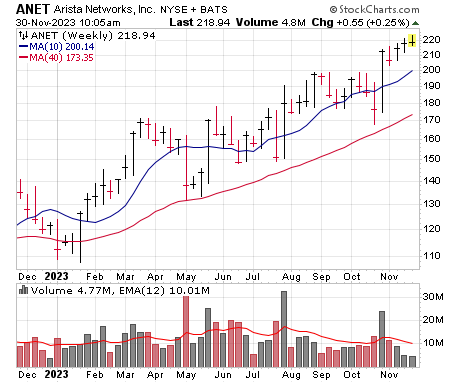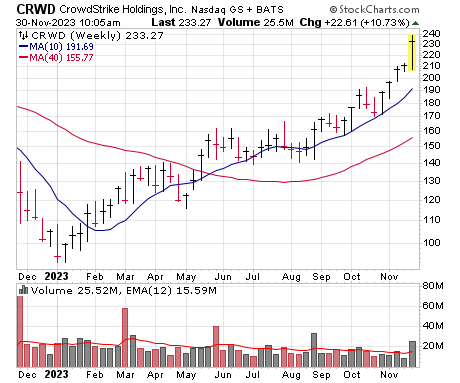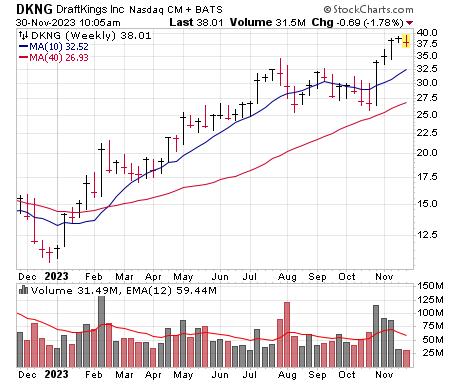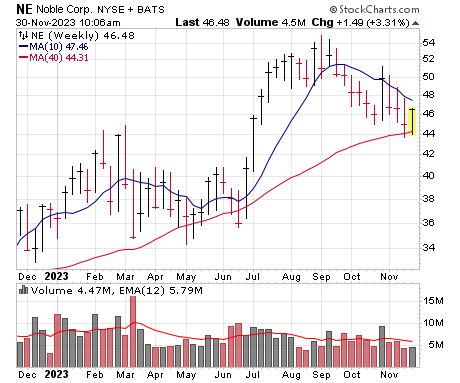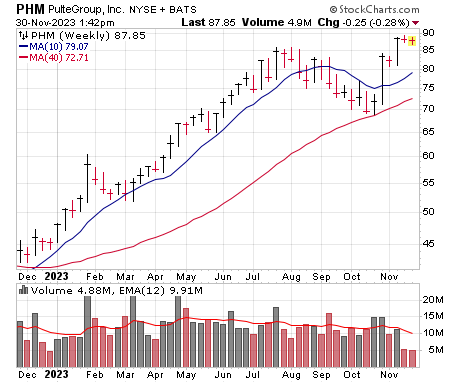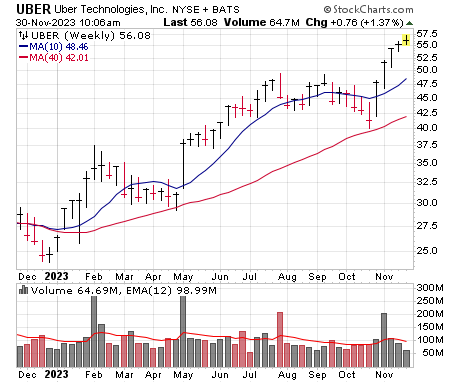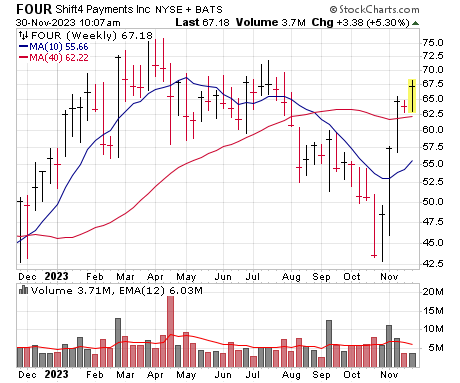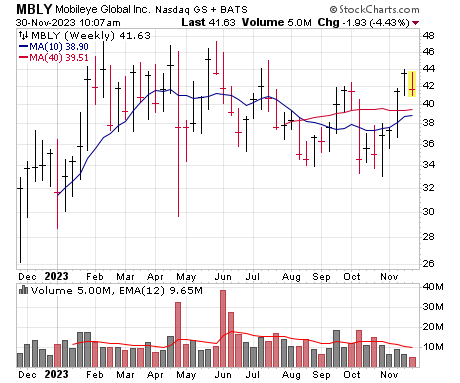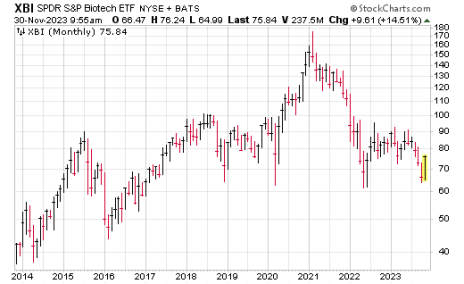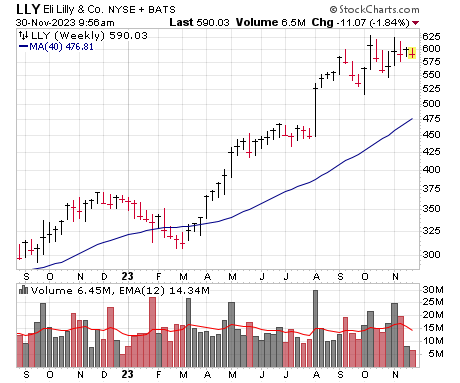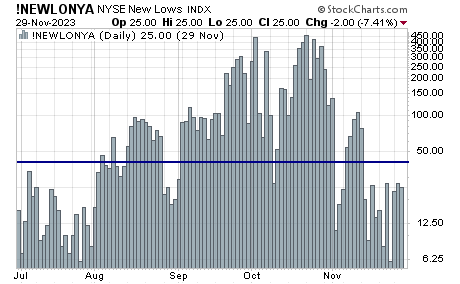Markets are Never Wrong; Opinions Are
There are still a lot of uncertainties in the world these days—the Middle East war is probably the biggest, including the possibility thay other countries may be pulled into it to some extent. And then there’s the economy, with the never-ending stream of data and its implications for Fed policy (next decision coming December 13), Treasury rates and a potential recession next year, which many are still pondering.
There’s no question all of those and other factors are important and, as we wrote on this page in the last issue, there are many investors that are focused on them. But the fact of the matter is that, if you wait until there are no uncertainties out there, you’re likely to be waiting a long time before buying—and when you do, it may be near a peak of some sort. Instead, you have to trust (to some extent) that the market’s ability to look three to six months down the road is often more accurate than even the best economic forecasters.
In other words, as Jesse Livermore said, markets are never wrong, but opinions often are. Right now, while there are still a lot of question marks in the real world, you really can’t see many of them if you’re sticking with the evidence: All three of our market timing indicators are now positive (our Two-Second Indicator has given an all-clear as the broad market has improved), while things like our Aggression Index (positive) and the intermediate-term trend in rates (down) are also encouraging.
True, individual growth stocks have been a little less robust, though that’s mostly because many are still repairing the damage from July through October; many growth funds fell 15% to 25% during that time, so many faster movers were off 25% to 35%. But even then, things are clearly improving whether looking at top-down measures (Nasdaq new highs hit a new four-month high yesterday) or by keeping an eye on a few dozen potential leaders.
Now, to be fair, we are seeing some short-term yellow flags—some extended leaders are finally starting to stall out, while this week has seen some spikes in speculative names, which, at least over the past couple of years, has usually led to some near-term turbulence. Toss in the simple fact that we’ve had a good run and some rotation and/or discomfort is a real possibility.
What to Do Now
That’s not a reason to run to your storm cellar, but it does have us continuing to favor a gradual buying plan, picking our stocks and entry points carefully as we focus on what look to be some real leaders. Last week, we averaged up on Duolingo (DUOL), which remains volatile but strong, while starting a position in Arista Networks (ANET); tonight we’re going to diversify the portfolio a bit, adding a half-sized stake (5% position) in Pulte Homes (PHM), a leader in a housing group that certainly acts like it wants to move higher. That will leave us with around 36% in cash.
Model Portfolio Update
Given the setup that the market put together in October, we’ve been open to more of a blastoff scenario, where tons of individual stocks break out and run—and, in the big-cap indexes, that has actually been a good description of what we’ve seen. But when it comes to the broad market and individual growth stocks, it’s been more of a gradual process—mostly to the good so far, with more names emerging and with more evidence flipping to the bullish side of the fence each week. Thus, we’ve been somewhat selective and gradual on the buy side, putting money to work in chunks as names emerge or tighten up.
We’re looking to follow that script going ahead, too, though we’re always flexible—near term, we’re seeing a few signs that the market could shake and bake a bit, so we’re not in a rush to floor the accelerator, per se, but we are making one move tonight. Last week before Thanksgiving, we averaged up on Duolingo and added a half-sized position in Arista Networks, and tonight we’ll buy a half position (5% of the portfolio) in Pulte Homes (PHM), which acts great and we think could surprise on the upside as the big-picture environment improves.
CURRENT RECOMMENDATIONS
| Stock | No. of Shares | Portfolio Weightings | Price Bought | Date Bought | Price on 11/30/23 | Profit | Rating |
| Arista Networks (ANET) | 418 | 5% | 218 | 11/22/23 | 220 | 1% | Buy a Half |
| CrowdStrike (CRWD) | 565 | 7% | 163 | 9/1/23 | 237 | 45% | Buy a Half |
| DraftKings (DKNG) | 6,200 | 12% | 29 | 6/23/23 | 38 | 30% | Buy |
| Duolingo | 852 | 10% | 214 | 9/17/23 | 212 | -1% | Buy |
| Noble (NE) | 2,346 | 6% | 52 | 8/25/23 | 46 | -12% | Hold |
| Nutanix (NTNX) | 4,591 | 11% | 39 | 11/3/23 | 43 | 11% | Buy |
| Pulte Homes (PHM) | - | -% | - | - | - | -% | New Buy a Half |
| Uber (UBER) | 3,037 | 9% | 44 | 5/19/23 | 56 | 27% | Buy |
| CASH | $749,348 | 41% |
Arista Networks (ANET)—As we’ve written before, Arista Networks has a couple of things that don’t exactly line up perfectly (such as its projected growth for most of 2024), but we’re putting more weight on (a) the stock’s long-term outperformance during the past couple of years, and (b) the big-volume move to new highs after earnings on Halloween—it was basically the first growth stock to zoom to new highs during this rally (actually a day before the rally started). If the stock falls back into the low/mid-190s, it would likely be a sign that big investors are believers in the slowdown thesis for next year (and would have us cutting the loss), but right here we’re thinking optimistically that big demand from the cloud titans plus potential upcoming AI design wins will keep perception on the upswing. We bought a half position (5% of the account) last week and are sitting tight tonight. BUY A HALF
CrowdStrike (CRWD)—CrowdStrike has been acting well for a while, and Tuesday night’s quarterly report was another great one that surpassed estimates: Annualized recurring revenue rose 35% to $3.15 billion (very fast growth at that size), earnings more than doubled as margins expanded and free cash flow was up 37% and totaled 98 cents per share (free cash flow margin was 30%, which is also the target for the full year). And, not surprisingly, the firm reiterated many of the longer-term targets it unveiled a couple of months ago, with free cash flow margins likely to rise to 36% within a few years, operating margins of 30% (up from 22% in this quarter) and total recurring revenue of $10 billion “over the next five to seven years.” There were many enticing nuggets on the conference call, though one that caught our eye was a simple concept, that CrowdStrike is the sector’s consolidator, not via M&A but via a broad-based platform that works and does everything clients need—“liberating organizations from a litany of increasingly ineffective legacy tools, multiple agents, [one-off] point products and fragmented platforms. Illustrating this point, deals with eight or more modules lifted 78% in the quarter.” The stock had already had a good run, of course, and it boomed after the report, remaining in a firm uptrend. Given the chart and some of the market’s near-term wobbles, some sort of dip is possible (the 25-day line is down around 198), so we’ll hold our half-sized stake right now … but will look to fill out the position on some sort of normal exhale in the days ahead. Right here we’ll stay on Buy a Half. BUY A HALF
DraftKings (DKNG)—DKNG has begun to level off a bit, but given the size of its post-earnings move, the stock looks fine, even after some press surrounding the ESPN Bet launch with Penn National. Interestingly, many are thinking that the bullish longer-term outlook released by the company at its Investor Day (EBITDA rising from a loss this year to $400 million next year, $1.4 billion in 2026 and $2.1 billion in 2028) could prove conservative. One big factor: DraftKings’ forecasts incorporated its current hold rate (how much of all bets it ends up keeping) of 9.5%, but some newer innovations from the firm (like progressive parlays) could drive the figure up to levels commonly seen in the U.K. and Australia, where 12% to 13% hold rates aren’t unusual. (We’d also note that the firm’s projections are only from states that are currently legalized, so more states hopping on the bandwagon would help.) We’ll see how it all goes, but the bottom line here is the firm is the leader in the field and cash flow should soar going forward. We’ll stay on Buy. BUY
Duolingo (DUOL)—Duolingo remains wild and wooly, but also in a strong uptrend. Given the action and its position on the chart, we decided to quickly average up last week (albeit in a smaller way, adding a 3% additional stake). Obviously, the potential here is great and we think the path of least resistance is up, but given the stock’s wildness, we’ll use a loose stop down in the 170 to 175 area (just below the prior high and under the current 50-day line, which is rising quickly) and simply play it by the book. Right here, we’re clearly optimistic that, after many false starts in recent months (including three separate 20%-plus corrections), DUOL has started a major uptrend as it’s lifted to all-time highs. That said, be prepared for some wild swings; today’s dip was sharp but looks normal on the chart. If you own some, hold on, and if you don’t, we’re OK buying some on this or further weakness. BUY
Noble (NE)—We’ve been patient with NE, partly because we sold a chunk at higher prices, but mostly because of the outlook here—barring a total collapse, it’s a sure thing that cash flow, buybacks and dividends are likely to kite meaningfully higher in the quarters to come, with plenty of potential upside as dayrates rise. Also, the stock is hanging around key support here (near the 200-day line/40-week line), just as OPEC is likely to slash production to support oil prices. Thus, the story here is the same: We’re hanging onto our remaining NE shares for now—if it can actually get moving, the upside could be very solid. But it’s on a super-tight leash, with much more weakness likely to prompt us to pull up our stakes and move on. HOLD
Nutanix (NTNX)—Nutanix’s underlying business remains in great shape, and when combined with its maturing transition to a subscription business model, it continues to lead to excellent results—as we saw in last night’s quarterly report. While revenue growth decelerated to 18%, the more telling figures like billings (up 24%), annualized recurring revenue (up 30% from a year ago and up 8.5% from Q2; makes up about 80% of total revenues at this point) operating expenses up just 2% and free cash flow (45 cents per share, up 190% and well ahead of reported earnings of 29 cents) all surpassed expectations and pointed to further good things down the road. Shares popped nicely higher this morning, though the churning in the market saw the name give up most of its gains by the close. Short-term, that may mean NTNX needs a bit of a rest (the 50-day line is down near 37.5), but while we’re always keeping our antennae up, the odds still favor higher prices ahead. BUY
Pulte Homes (PHM)—If we had our druthers, our portfolio would contain (about) 10 emerging blue chip-type growth stocks from a variety of industries and sub-sectors like software, chips, Internet, business productivity, retail, medical and more—all areas that have spawned big winners in the past. However, there are a couple of areas outside of traditional growth that have a history of trending if conditions are right—and homebuilders are one of those, so with the Fed (likely) having called off the dogs, with interest rates having settled down and with the economy (likely) still in decent shape, all while housing inventory is hard to find, prices should stay firm and demand for new houses strong. Pulte serves different segments of the market, too, including first-timers (38% of homes closed in Q3), move-ups (37%) and active adult (25%), the latter of which also has a good number of cash buyers. The bottom line is that, despite high and rising mortgage rates, analysts in February saw this year’s earnings for Pulte of around $7 per share—but now they see $11.50, and they should at least remain elevated going ahead. As we wrote in the last issue, the stock has shown great power (elephant tracks) during the past month and is now trading very tight. We thought about buying a full-sized stake, but peer Toll Brothers (TOL) reports earnings early next week, so we’ll start with half (5% of the portfolio) here and look to average up if all goes well. BUY A HALF
Uber (UBER)—UBER remains a super-strong stock, nosing higher on most days regardless of what’s going on in the market. Obviously, there are never any guarantees, but it certainly appears that Uber is moving into “liquid leader” status, with tons of big investors taking and building positions as strong sales and (especially) cash flow growth looks like a very good bet for many quarters to come. Playing into that view is something that is a bit underrated here—as recently as a few months ago, competition from the likes of Lyft could move this stock, but today, it’s clear Uber is the leader in ride-sharing. (There is competition in delivery, but both it and DoorDash (DASH) are doing well there.) Of course, at some point, UBER is going to pull in somewhat, so if you’re not yet in, keep it small and/or aim for dips. Still, barring a massive downside move or a break in the overall market, the first pullback after this thrust should be buyable and lead to another leg up. BUY
Watch List
- Eli Lilly (LLY 591) and Novo Nordisk (NVO 102): LLY and NVO have been mostly meandering in recent weeks—but doing nothing wrong as they trade tightly. (A meta-study showed that Lilly’s offering did better than Novo’s, but both stocks continue to swim together.) See more later in this issue; a big upmove from here could kick off a fresh advance, but we need to see it start first.
- Elastic (ESTC 80): We continue to think ESTC is set up well, both fundamentally (its corporate search platform is growing nicely—and perfectly suited for the new AI age) and technically (17%-deep rest over six weeks after a September blastoff). Earnings are due out tonight.
- Expedia (EXPE 136): It’s not a rapid grower anymore, but Expedia looks like an interesting turnaround situation with huge cash flow, growing sales and earnings, a reasonable valuation and a big shareholder return program—as well as a super-powerful chart.
- Nvidia (NVDA 486): NVDA has struggled since earnings last week, but the numbers here remain insane and the damage (the stock is still above its 25-day line) hasn’t been bad. A major show of strength could start a breakout from its three-month range.
- Palantir (PLTR 20): PLTR recently announced a deal with the National Institute of Health in Britain—though it was a bit smaller than hoped for, causing the stock to exhale. Even so, the damage was limited, and the stock is starting to find support.
- Shift4 (FOUR 66): FOUR fell a whopping 44% from high to low this year but has come storming back after the Q3 report basically killed the bear case that had been running wild most of this year. It needs more time but it’s possible the strong hands have finally moved in. See more below.
- Snowflake (SNOW 188): SNOW has always had liquid leader written all over it, as the firm has effectively invented a new cloud segment (data cloud) that tons of huge enterprises are using (and using more). Growth is slowing some, but that’s likely been discounted by the market, and it’s now testing 15-month highs after earnings last night.
Other Stocks of Interest
Shift4 (FOUR 66)—While the big-cap indexes bottomed more than a year ago, in October 2022, what’s less well known is that much of the broad market just retested its 2022 lows a few weeks back; the Russell 2000 small-cap index actually kissed a new multi-year low! That’s a big reason why we saw so many smaller growth stocks get punished in the summer and fall (down 40% or more) even when business was just fine—and now that the market is shaping up, some are storming back in a big way. Shift4 was a name we were very high on, and while it’s cold comfort given the stock’s 44% plunge from April to October, just about everything we were looking at fundamentally has come true. The firm’s payment hardware and software has a lot of advantages (including usability and lower costs; it says its SkyTab point-of-sale offering is less than one-third the five-year cost of its closest competitor) compared to many peers, which is one reason why it’s grown revenues at a double-digit pace for 24 straight years (even through the Great Recession and the pandemic) and why it’s attracting bigger fish (average merchant size is triple what it was in 2021). The firm’s core business of restaurants and hospitality remains very strong as Shift4 expands modest deals and inks a bunch of new big clients, and then there are other sectors the firm has been diving into that should kick into gear soon. Sports and entertainment is a big one (Orlando Magic, Miami Dolphins, Univ. of Georgia, San Francisco 49ers, Oklahoma City Thunder all have gone live recently), but there’s also non-profits (8,000 clients including some big names), what it calls sexy tech (the largest timeshare rental and resale site is signed up) and other ticketing deals, too. Plus, with the recent closing of its Finaro transaction, international sign-ups should be big—the top brass is aiming to add more than 10,000 restaurants to the client list in Europe and Canada next year! The fear here was that growth would collapse with the economy and competition, and there were also some lingering worries about a short-sale report from the spring, but the Q3 report and (more important) outlook seemed to turn perception on a dime—Q3 net revenue rose 24% from a year ago, payment volume rose 36% and EBITDA boomed 46%, while free cash flow came in north of 90 cents per share. Moreover, management provided an early 2024 view that sees organic payment volume growth of 47% next year, and that seemed to have some very conservative assumptions built into it. (Analysts see earnings and EBITDA up in the 30% range next year.) In response, FOUR recovered two-thirds of its seven-month decline in just three weeks and has refused to give any of it back. There is overhead in this area, so it’s probable the stock will need time to gather strength, but this is a story we loved earlier this year—and now it looks like the market could be ready to reward it as growth continues unabated. It’s back on our watch list.
Mobileye (MBLY 41)—Mobileye is all about advanced driver assistance systems (ADAS; think lane guidance and emergency braking), which are included in many cars these days, as well as autonomous driving capabilities via its SuperVision (hands off but eyes open) and, eventually, Chauffer (hands and eyes off) products—all thanks to the firm’s chips that process images from many different cameras, effectively a best-in-class vision perception system for autos. The “problem” with all of this is that, while Mobileye does great business today (revenues of near $2 billion, earnings solidly in the black with pre-tax profit margins usually north of 30%, mostly due to its lead in ADAS systems), the stock is really trading on the future—specifically, a ramp in the autonomous SuperVision and Chauffer offerings—while there are other moving parts as well, including a lot of recent CapEx to rebuild inventories the past few months and the fact that Intel still owns a ridiculous 88% of this company (and will piece out of it over time). Still, when reading the tea leaves, there’s no doubt Mobileye is making major progress. First off, it expects future bookings this year to surpass last year’s record tally (which brought in $6.7 billion of future revenue); 2024 should see SuperVision shipments more than double; nearly every SuperVision customer currently has a plan to eventually scale up to Chauffer, which is higher margin; the firm has either booked or is in advanced talks with 10 automobile OEMs that combined produce 34% of the world’s output, up from just three OEMs at the start of 2023; and, in terms of numbers, margins and free cash flow should improve next year as CapEx from the inventory rebuild eases and more SuperVision-enabled car production comes online. Now, to be fair, analysts see earnings up just 10% or so next year, though they do see revenues surging 40% and the story for 2025 and beyond is super bullish as more automakers launch models integrating Mobileye’s wares. It seems like just a matter of time before things really take off on the upside, but we’re waiting for a sign from the stock itself that big investors are discounting that future—MBLY has perked up nicely of late, but remains within its long consolidation that started way back in February. Some sort of decisive strength (possibly on news of new orders or a 2024 outlook) would be intriguing.
Datadog (DDOG 117)—While we’re not techies, there are a couple of long-term tech trends that are easy to understand—and keep producing winners most years. The first is cybersecurity, the need for which is only going to grow as more data, commerce and the like goes online; that’s why so many firms in the space (like CrowdStrike) continue to grow at rapid rates year after year. The second trend is observability, which allows mid- to large-sized outfits to make sure that all their myriad apps (the number of which has exploded in recent years) are working (and working together) as they should. Datadog has long been a leader in observability, with a single platform that solves this puzzle—it started years ago with infrastructure monitoring, advanced to application monitoring and now includes log management, cloud security, digital experience monitoring (monitoring the user experience on browsers or apps, etc.), security and even workflow management, with a total of 19 offerings (46% of clients use at least four of them). The market is big but still growing fast (expected to expand nearly 40% from 2023 to 2026), and while there’s competition, there’s no doubt Datadog is one of the top players in the field. It has 26,800 customers (up 22% from a year ago), of which more than 3,100 produce six figures of recurring revenue and 317 spend over $1 million per year; the gross retention rate is in the mid- to high-90% range, too, so once companies sign up, they stay signed up. Now, as tech spending has slowed, so has Datadog’s growth—Q3 revenues grew “only” 25% and analysts see 20% expansion in Q4 and next year as a whole. Even so, those figures are likely conservative (Q3 results destroyed estimates, and forward-looking indicators like billings (up 30%) and remaining performance obligations (up 54%) grew at faster rates), but also, the stock has likely discounted the long slowdown over the past couple of years: DDOG crashed 70% during the bear market and was still down 60% from its all-time highs a month ago when the earnings report caused a huge rush of buying (biggest weekly volume since May 2020) as investor perception turns up. We prefer newer names that didn’t already have big runs, but history shows that a select few prior leaders can lead again during the next bull cycle, and Datadog’s combination of a great story, consistent and solid growth numbers and (now) a strong chart puts it in position to be one of them.
Can Biotech Finally Produce some Leaders?
We don’t have many complaints when it comes to the market’s rally at this point—in fact, if you had to write a script, it would have been hard to write a better one for the past month. That said, while the pickings haven’t necessarily been slim for growth investors, they have been concentrated in the technology area—cybersecurity, software, networking and the like. Of course, we have no issue with technology stocks, as many of our biggest winners over time have been some sort of tech plays, with the last big run (right during the pandemic) possibly being the most fruitful of them all.
That said, things usually work best when growth stocks come from a few different segments, not just tech. One that we write about frequently is retail—give us a good, long-lasting cookie-cutter story and some profit cushion, and we may hold the name for years. Even beyond traditional retail are consumer-facing companies that serve mass markets; Google and Apple are the biggest examples, and in the Model Portfolio, stocks like Uber and Duolingo fill the bill.
Besides retail and consumer facing outfits, the other traditional growth area that usually shows up is medical and biotech, both of which are still in the process of repairing the damage from recent months—and recent years. Indeed, as of a month ago, the SPDR Biotech Fund (XBI) had been dead money for an unbelievable eight and a half years!
While we never anticipate a change in trend, logic tells us that at some point biotech in particular is going to get moving—and if that happens soon, it should even produce some real growth stock leadership to feast on. Below are a few names in the broad biotech group we’re keeping an eye on that, if the recent bounce in the sector continues, could thrive.
The first two are names we’ve written about recently and are on the lips of many investors: Eli Lilly (LLY) and Novo Nordisk (NVO), both of which are leading a potential weight-loss revolution with their Zepbound (Lilly) and Wegovy (Nordisk) drugs that could be the biggest selling drugs in history. (Both firms, especially Lilly, have other big-selling offerings and potential new releases coming, too.) The question is whether a lot of the good news has already been discounted (both stocks have $500 billion-ish market caps!), but we’ll let the stocks decide—powerful upside moves in both would certainly be a good sign, especially after both have traded very tightly of late.
Looking past the mega-caps are many names that have great potential, including one we followed for a while last year before it got caught up in the market decline. Intra-Cellular Therapies (ITCI) has something special with its Caplyta treatment—it was on the market for schizophrenia starting in March 2020 and and saw solid growth (from zero to 2,000 prescriptions per month) through 2021, but then came a broad approval for bipolar depression, which has bumped the prescription figures to an average of 8,500 during the past two years. (It’s the only therapy approved for both bipolar I and II both as a stand-alone and combo offering.) Given that there are 11 million bipolar sufferers in the U.S. alone, the potential is huge—but Intra-Cellular is in Phase III trials with Caplyta for major depressive disorder, which is a market potentially twice the size of bipolar! (Clinical data released back in March was superb.) Sales growth is slowing as the figures get larger, but revenues still rose 76% in Q3, with 2024 expected to bring a 41% gain (likely conservative), with tons of upside if/when MDD approval hits down the road. ITCI has been range bound since April of 2022, but is showing some solid strength since the market low.
Lastly, we had written up Immunogen (IMGN) here—but just this morning, the firm agreed to be bought out by AbbVie for a huge premium thanks to its Elahere treatment for ovarian cancer; that’s a good sign that deep-pocketed firms are on the hunt, which is good for the group.
Another name to watch is Neurocrine Biosciences (NBIX), which has been riding the success of Ingrezza, a drug that treats tardive dyskinesia, which can cause muscle spasms in the face, neck and elsewhere; it also got FDA approval in August for the drug to be used for chorea (involuntary movements with those who have Huntington’s). Ingreeza makes up basically all of the revenue pie today (should be $1.8 billion this year, with big profits too), though there’s excitement about another drug that showed great Phase III trial results for treating a group of genetic disorders, too—management thinks it can be the standard of care for that market and plans to submit plans to the FDA next year. NBIX had a nice rally into September and has now been hacking around for two and a half months; next week’s (December 5) Analyst Day could provide a catalyst.
Of course, these stocks and the biotech/medical sector as a whole still have to confirm that the trend has changed, but given some of the exciting stories among firms with legitimate drugs on the market (not just pipe dream development stage lottery tickets) and the long period of underperformance, we’re thinking some names could launch if the market remains upright.
Cabot Market Timing Indicators
There are still some headwinds out there, including the fact that many growth areas are still repairing the damage they suffered during the July-October decline, and near-term, we’re finally seeing some churning in extended leaders. But there’s no question that the evidence has been improving on a weekly basis, with our Two-Second Indicator the latest to join the bullish parade. While we’re picking our spots, we remain optimistic.
Cabot Trend Lines: Bullish
Oftentimes when the market or indicator comes right down to a key level and holds, it leads to a powerful move—a shakeout and recovery of sorts. That’s just what we’ve seen following the successful test by the Cabot Trend Lines two weeks ago, with a straight-up rally in the big-cap indexes ever since, leaving them safely north of their 35-week lines. That keeps the longer-term in the same bullish stance it’s been since late January.
Cabot Tides: Bullish
Our Cabot Tides remain in good shape following their recent buy signal, with all five indexes (including the S&P 400 MidCap, shown here) above their rising moving averages. At this point, with the 50-day line now the lower of the two averages, a sell signal would only be generated if that line is broken, so there’s plenty of wiggle room should the indexes finally exhale. Right now, with both the intermediate- and longer-term trends pointed up, you should continue to look to put money to work.
Two-Second Indicator: Positive
Our Two-Second Indicator has sounded an all-clear signal, with 12 straight days (including today) of fewer than 40 new lows on the NYSE. To be fair, last week’s holiday trading likely helped the figures, and any market pullback could affect the figures, so we’ll keep our eyes open. But going with what we see now, it’s clear that more and more of the broad market is kicking into gear.
The next Cabot Growth Investor issue will be published on December 14, 2023.
